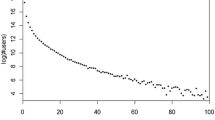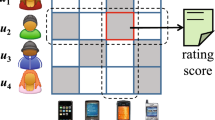Abstract
Review texts, which have been shown helpful for recommending items for users, are often available in the form of user feedback for items. Despite the success of previous approaches exploring reviews for recommendations, they are all based on long review texts. The users reviews are, however, often short in real-world applications. In this paper, we develop a novel approach to leverage information from short review texts for recommendation based on word vector representations. We first build word vectors to represent items and users, which are called item-vector and user-vector, respectively. After that we concatenate item-vectors and user-vectors to form a set of training data with the rating scores that users give to items. Finally we train a regression model to predict the unknown rating scores. In our experiment, we show that our approach is effective, compared to state-of-the-art algorithms.







Similar content being viewed by others
References
McAuley JJ, Leskovec J (2013) From amateurs to connoisseurs: modeling the evolution of user expertise through online reviews. In: Proceedings of the 22nd international world wide web conference, pp 897–908
Lerman K, Blair-Goldensohn S, McDonald RT (2009) Sentiment summarization: evaluating and learning user preferences. In: Proceedings of EACL, pp 514–522
Sharma A, Cosley D (2013) Do social explanations work?: studying and modeling the effects of social explanations in recommender systems. In: Proceedings of the 22nd international world wide web conference, pp 1133–1144
Petz G, Karpowicz M, Fürschuß H, Auinger A, Stríteský V., Holzinger A (2015) Reprint of: computational approaches for mining user’s opinions on the Web 2.0. Inf Process Manage 51(4):510–519
Ganu G, Elhadad N, Marian AM (2009) Beyond the stars: Improving rating predictions using review text content. In: Proceedings of the 12th international workshop on the web and databases, pp 443–451
Agarwal D, Chen B-C (2010) fLDA: matrix factorization through latent dirichlet allocation. In: Proceedings of the 3rd international conference on web search and web data mining, pp 91–100
Wang C, Blei DM (2011) Collaborative topic modeling for recommending scientific articles. In: Proceedings of the 17th ACM SIGKDD international conference on knowledge discovery and data mining, pp 448–456
McAuley JJ, Leskovec J, Wang C, Blei DM (2013) Hidden factors and hidden topics: understanding rating dimensions with review textCollaborative topic modeling for recommending scientific articles. In: Proceedings of the 7th ACM conference on recommender systems, pp 165–172
Ling G, Lyu MR, King I, Blei DM (2014) Ratings meet reviews, a combined approach to recommend. In: Proceedings of RecSys, pp 105–112
Zhao F, Xiao M, Guo Y (2016) Predictive collaborative filtering with side information. In: Proceedings of IJCAI, pp 435–447
Turian JP, Ratinovand L-A, Bengio Y (2010) Word representations: A simple and general method for semi-supervised learning. In: Proceedings of the 48th annual meeting of the association for computational linguistics, pp 384–394
Mikolov T, Sutskever I, Chen K, Corrado GS, Dean J (2013) Distributed representations of words and phrases and their compositionality. In: Proceedings of advances in neural information processing systems, pp 3111–3119
Le QV, Mikolov T (2014) Distributed representations of sentences and documentsy. In: Proceedings of the 31th international conference on machine learning, pp 1188–1196
Huang W, Zhaohui WU, Liang C, Mitra P, Lee Giles C (2015) A neural probabilistic model for context based citation recommendation. In: Proceedings of AAAI, pp 968–977
Koren Y, Bell RM, Volinsky C (2009) Matrix factorization techniques for recommender systems. IEEE Comput 42(8):30–37
Diao Q, Qiu M, Smola AJ, Jiang J, Wan C (2014) Jointly modeling aspects, ratings and sentiments for movie recommendation. In: Proceedings of the 20th ACM SIGKDD international conference on knowledge discovery and data mining, pp 193–202
Blei DM, Ng AY, Jordan MI (2003) Latent Dirichlet Allocation. J Mach Learn Res 3:193–202
Koren Y, Bell RM (2011) Advances in collaborative filtering. Recommender systems handbook, pp 145–186
Wang S, Li F, Zhang M (2011) Supervised topic model with consideration of user and item. Late-breaking developments in the field of artificial intelligence, pp 315–324
Mesnil GR, Mikolov T, Marc’Aurelio R, Bengio Y (2014) Ensemble of generative and discriminative techniques for sentiment analysis of movie reviews. In: Proceedings of CoRR, arXiv:1412.5335
Xin X, Liu Z, Lin C-Y, Huang H, Wei X, Guo P (2015) Cross-domain collaborative filtering with review text. In: Proceedings of the 24th international joint conference on artificial intelligence, pp 1827–1834
Guang-Neng HU, Dai X-Y, Song Y, Huang S, Chen J (2015) A synthetic approach for recommendation: combining ratings, social relations, and reviews. In: Proceedings of the 24th international joint conference on artificial intelligence, pp 1756–1762
Mikolov T, Sutskever I, Chen K, Corrado GS, Dean J (2013) Distributed representations of words and phrases and their compositionality. In: Advances in neural information processing systems, pp 3111–3119
Morin F, Bengio Y (2005) Hierarchical probabilistic neural network language model. In: Proceedings of the international workshop on artificial intelligence and statistics, pp 246–252
Breiman L (2001) Random forests. Mach Learn 45(1):5–32
Xue H-J, Dai X, Zhang J, Huang S, Chen J (2017) Deep matrix factorization models for recommender systems. In: Proceedings of the 26th international joint conference on artificial intelligence, pp 3203–3209
Fang H, Zhen Z, Shao Y, Hsieh C-J (2017) Improved bounded matrix completion for large-scale recommender systems. In: Proceedings of the 26th international joint conference on artificial intelligence, pp 1654–1660
Wang Y, Wang S, Tang J, Qi G-J, Liu H, Li B (2017) CLARE: A joint approach to label classification and tag recommendation. In: Proceedings of the 31st conference on artificial intelligence, pp 210–216
Gao L, Wu J, Zhou C, Hu Y (2017) Collaborative dynamic sparse topic regression with user profile evolution for item recommendation. In: Proceedings of the 31st conference on artificial intelligence, pp 1316–1322
Li D, Chen C, Lv Q, Shang L, Chu SM, Zha H (2017) ERMMA: Expected risk minimization for matrix approximation-based recommender systems. In: Proceedings of the 21st conference on artificial intelligence, pp 1403–1409
Wang H, Wu Q, Wang H (2017) Factorization bandits for interactive recommendation. In: Proceedings of the 31st conference on artificial intelligence, pp 2695–2702
Sedhain S, Menon AK, Sanner S, Xie L, Braziunas D (2017) Low-rank linear cold-start recommendation from social data. In: Proceedings of the 31st conference on artificial intelligence, pp 1502–1508
Author information
Authors and Affiliations
Corresponding author
Additional information
Publisher’s note
Springer Nature remains neutral with regard to jurisdictional claims in published maps and institutional affiliations.
Rights and permissions
About this article
Cite this article
Zheng, X., He, W. & Li, L. Distributed representations based collaborative filtering with reviews. Appl Intell 49, 2623–2640 (2019). https://doi.org/10.1007/s10489-018-01406-z
Published:
Issue Date:
DOI: https://doi.org/10.1007/s10489-018-01406-z




